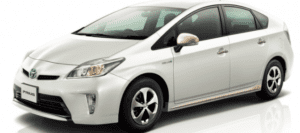Toyota Prius Repair Manual HYBRID ZVW30 2009-2014

The Toyota Prius Hybrid ZVW30 refers to the third generation of the Toyota Prius, a hybrid electric vehicle that was produced from 2009 to 2015. The ZVW30 chassis code specifically identifies this generation. The Prius is known for its fuel efficiency and innovative hybrid technology. Here are some key features and details about the Toyota Prius Hybrid ZVW30:
- Hybrid Powertrain:
- Engine:
- The gasoline engine in the Prius ZVW30 is typically a 1.8-liter Atkinson-cycle four-cylinder engine. This engine works in conjunction with an electric motor to provide power to the wheels.
- Electric Motor and Battery:
- The electric motor in the Prius ZVW30 is powered by a nickel-metal hydride (Ni-MH) battery pack. The electric motor assists the gasoline engine during acceleration and can also propel the vehicle at low speeds using electric power alone.
- Fuel Efficiency:
- The primary advantage of the Prius is its exceptional fuel efficiency. The hybrid system allows for regenerative braking, where energy is recaptured during braking and used to recharge the battery. This, along with the ability to operate on electric power at low speeds, contributes to improved fuel economy.
- Transmission:
- The Prius ZVW30 typically comes with an electronically controlled continuously variable transmission (ECVT). The ECVT allows for smooth and efficient power delivery.
- Body Styles:
- The Prius ZVW30 was available in different body styles, including a compact hatchback design. The aerodynamic shape of the Prius contributes to its fuel efficiency.
- Interior Features:
- The interior of the Prius is designed for comfort and functionality. Depending on the trim level, features may include a touchscreen infotainment system, navigation, climate control, and advanced safety features.
- Safety Features:
- The Prius ZVW30 is equipped with safety features such as airbags, anti-lock brakes, stability control, and traction control. Higher trim levels may include additional advanced safety features.
- Trim Levels:
- The Prius ZVW30 was available in different trim levels, each offering various features and options. Higher trim levels often included more advanced technology and comfort features.
- Updates and Facelifts:
- Throughout its production span, the Prius ZVW30 underwent updates and facelifts to incorporate new features and styling changes.
- Environmental Impact:
- The Prius, being a hybrid vehicle, is designed to reduce greenhouse gas emissions and fuel consumption, contributing to a lower environmental impact compared to traditional gasoline-powered vehicles.
As with any vehicle, the specific features and options available may vary depending on the model year and market. If you are considering purchasing a used Toyota Prius ZVW30, it’s recommended to check the vehicle’s history, maintenance records, and overall condition.
TOYOTA PRIUS ZVW30 2009-2014 REPAIR MANUAL
The contents of a repair manual for the Toyota Prius Hybrid ZVW30 would typically include a wide range of information to guide technicians, mechanics, or even DIY enthusiasts through maintenance, diagnostics, and repair procedures. While the specific content may vary depending on the publisher, here are common sections and topics you might find in a repair manual for the Toyota Prius ZVW30:
- Introduction:
- General information about the vehicle.
- VIN (Vehicle Identification Number) decoding information.
- Specifications and technical data.
- Maintenance:
- Scheduled maintenance intervals and procedures.
- Fluid capacities and specifications.
- Inspection and replacement procedures for essential components.
- Engine System:
- Engine specifications.
- Removal and installation procedures.
- Hybrid system overview and components.
- Transmission System:
- Transmission specifications.
- Continuously Variable Transmission (CVT) overview.
- Removal and installation procedures.
- Hybrid System:
- Hybrid system components and operation.
- High-voltage safety precautions.
- Inverter and battery system diagnostics and repair.
- Steering and Suspension:
- Steering and suspension system specifications.
- Strut and shock absorber replacement.
- Power steering system diagnostics and repair.
- Brake System:
- Brake system overview.
- Brake pad and rotor replacement.
- Brake caliper and master cylinder service.
- Regenerative braking system explanation.
- Body and Exterior:
- Body and frame specifications.
- Exterior lighting system.
- Door, window, and exterior panel removal and installation.
- Interior Components:
- Interior trim removal and installation.
- Dashboard and instrument panel components.
- Air conditioning and heating system diagnostics and repair.
- Electrical System:
- Electrical system overview.
- Wiring diagrams for various circuits.
- Battery, alternator, and starter diagnostics and replacement.
- Troubleshooting and Diagnostics:
- Common issues and diagnostic procedures.
- Diagnostic trouble codes (DTCs) and their meanings.
- Hybrid system diagnostic procedures.
- Safety Features:
- Airbag system overview.
- Safety precautions and procedures.
- Index:
- An index to help locate specific information quickly.
- Technical Service Bulletins (TSBs):
- Information about known issues and recommended solutions provided by the manufacturer.
- Torque Specifications:
- Detailed torque specifications for various components.
Remember that the specific content may vary between different repair manual publishers, and it’s essential to use a manual that is designed for the exact make, model, and year of your Toyota Prius ZVW30. Always follow safety precautions and use the manual as a guide for appropriate vehicle maintenance and repair.

